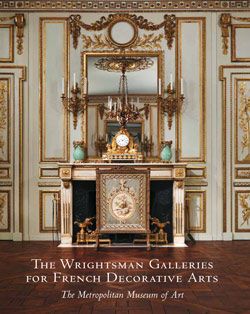Carpet with Fame and Fortitude
Manufactory Savonnerie Manufactory
after designs by Charles Le Brun French
after designs by Louis Le Vau French
In his A New Description of Paris, of 1687, Germain Brice (1652–1727) mentioned work in progress on “a great Footcloath in the manner of Turky-work, . . . in a place built on purpose at the end of the Cours de la Reine, commonly called the Savonnerie, which is to be the full length of the great Gallery of the Louvre, but is not yet finisht.” Brice referred here to a set of ninety-three carpets, of different but related designs, that was being created for the Grande Galerie of the Palais du Louvre in Paris. The Savonnerie manufactory, which received a monopoly from Louis XIII in 1627 to make knotted-pile rugs in the manner of the Levant, experienced its most creative period under Louis XIV, when the workshops were placed under the direction of the king’s First Painter, Charles Le Brun. The project to cover with carpets the entire floor of the long gallery at the Louvre, measuring more than 480 yards in length, was the most ambitious commission the Savonnerie ever received. The work space was expanded and extra-wide looms were created to accommodate this monumental task. Contrary to tradition, the size of the looms was based on the length of the carpets (which in turn was determined by the width of the long gallery ). The individual designs of the series most likely reflected in some degree the decoration of the ceiling and walls of the gallery.
Set against a black ground with scrolling acanthus leaves in the corners, the main motifs of the Museum’s splendid carpet, number thirty-eight of the series, are full of references to the monarchy. The sunflower, symbol of the Sun King, is flanked by the French royal arms and by Louis XIV’s crowned monogram of interlaced Ls.
A number of the carpets for the Grande Galerie have compartments at either narrow end showing simulated bas-reliefs in grisaille representing different aspects and virtues of good government. Here the personifications of fame, blowing a trumpet, and fortitude, with a lion and a column, are depicted. Although all the carpets of the original commission but one were woven between 1670 and 1689, Louis XIV appears to have lost interest in the interior decoration of the Louvre, and thus in this monumental project, when he focused his attention on Versailles instead, moving his court there in 1682. When Horace Walpole visited the Louvre in August 1771 the palace was in a derelict state. “Saw the great gallery of Le Brun with battles of Alexander, all the ornaments, ceiling, shutters and even locks and bolts designed by Le Brun, but so abominably neglected that it rains in.” Perhaps it was not such a bad thing after all that the series of Savonnerie carpets appears never to have been laid out in the Grande Galerie as originally intended.
#2272. Carpet
This image cannot be enlarged, viewed at full screen, or downloaded.
This artwork is meant to be viewed from right to left. Scroll left to view more.





